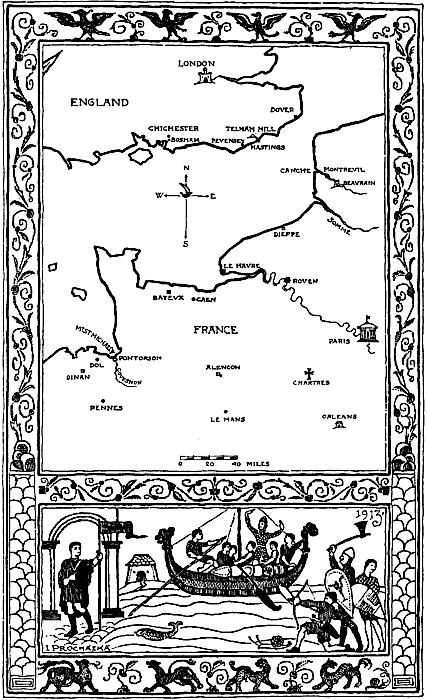
The cover image was created by the transcriber and is placed in the public domain.
THE BOOK OF
THE BAYEUX TAPESTRY
- Transcriber’s Notes:
- Additional information about the Bayeux Tapestry can be found here:
https://en.wikipedia.org/wiki/Bayeux_Tapestry
- Much nicer images of the tapestry itself can be found here:
https://www.bayeuxmuseum.com/en/the-bayeux-tapestry
- Additional information about the Bayeux Tapestry can be found here:

INTRODUCTION
At Bayeux in Normandy, a little town as old perhapsas our race and older certainly than our records andour religion, there is to be seen in the main room ofwhat was once the Bishop’s Palace a document uniquein Europe. There is no other example, I think, ofa record, contemporary or nearly contemporary, of anevent so remote in the story of Christendom, detailedupon so considerable a scale and relating to a matter ofsuch moment. It is these three characters combinedwhich give to the Bayeux Tapestry its value. We have,indeed, pictorial representation more accurate and moredetailed in some few cases, but relating to the periodswhen material civilisation was high—before the DarkAges. We have again an ample store of evidencepictorial and written, relating to the vivid life of theearlier Middle Ages, and of course, an overwhelmingmass of matter dealing with everything that accompaniedor has succeeded the Renaissance. Even of the DarkAges and of that violent and happy transition from theDark Ages to Mediæval civilisation, we have here andthere sharp pictures—mostly pictures of the pen andnot of the pencil. But these pictures relate—almostalways—episodes which were not the capital episodes oftheir time. The Bayeux Tapestry stands quite apart inthis: that it represents so faithfully and so thoroughlyvione of the half-dozen acts essential to the remaking ofEurope, and that it so represents an act which, on theanalogy of every other of that early time, we shouldexpect to receive only from a short and doubtful literaryaccount. It is the one picture we have of any magnitudeshowing us the things of the Crusading turning-point.For Western Christendom, as we know, awokefrom its sleep and fl